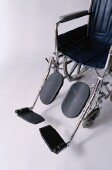- Skip Storing This Everyday Product in the Fridge Door
- Green Tea + B3 Pairing May Boost Brain Health
- Navigating Your Midlife Crisis: Embracing New Possibilities
- City Raccoons Showing Signs of Domestication
- Mapping the Exposome: Science Broadens Focus to Environmental Disease Triggers
- One Week Less on Social Media Linked to Better Mental Health
- Your Brain Changes in Stages as You Age, Study Finds
- Some Suicide Victims Show No Typical Warning Signs, Study Finds
- ByHeart Formula Faces Lawsuits After Babies Sickened With Botulism
- Switch to Vegan Diet Could Cut Your Greenhouse Gas Emissions in Half
Researchers Measure Scope of Muscular Dystrophies That Strike Boys


A new study estimates the prevalence of two types of muscular dystrophy that strike mostly boys.
A team led by researchers from the University of Iowa found that about one in 5,000 boys between the ages of 5 and 9 have either Duchenne muscular dystrophy or Becker muscular dystrophy. The researchers also found that Hispanic boys were struck by the disorders more often than whites or blacks.
“There were always some rather crude estimates of how common these muscular dystrophies are,” study corresponding author Paul Romitti, an epidemiologist at the University of Iowa, said in a university news release. “It tells us that they’re still an important public health concern.”
In the study, the team analyzed data from children born in six states — Arizona, Colorado, Georgia, Hawaii, Iowa and New York — between 1982 and 2011.
The reasons why the disorders affect Hispanic boys more often than whites or blacks are not well understood, according to the authors of the study, published online Feb. 16 in the journal Pediatrics. But the findings do give a better idea of how many American children and families are affected by the two diseases, the researchers said.
Of the 845 cases in the study, three-quarters were Duchenne muscular dystrophy, the investigators found. Patients with Duchenne muscular dystrophy lose the ability to walk between the ages of 7 and 13, and die in their teens or 20s.
Becker muscular dystrophy is similar to Duchenne, but begins at a later age and has a slower, more variable progression of symptoms. There is no cure for either disorder, the study authors noted in the news release.
Even though the disorders are rare, doctors need to be prepared to deal with them, the study authors said.
“People who have these disorders require daily attention from their families and complex-care management from health-care providers,” Romitti said. “The new data will help to estimate the cost for the parents and the health-care system. We are continuing to learn more about the total impact of these disorders on the child and the family.”
More information
The U.S. National Library of Medicine has more about muscular dystrophy.
Source: HealthDay
Copyright © 2025 HealthDay. All rights reserved.










